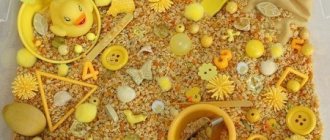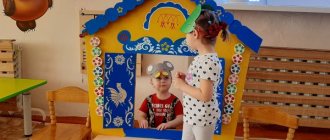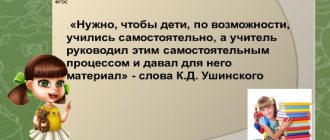The structure of an individual lesson at the stage of sound production
- Organizing time
- Articulation exercises: general articulation exercises, special articulation exercises, exercises to develop the strength of the voice and exhalation.
- Announcing the topic of the lesson to the child.
- Sound production (by imitation, from a preserved phoneme, from articulation exercises, by mechanical influence).
- Analysis of articulation according to plan: position of the lips, position of the teeth, position of the tongue (tip, back, root), participation of the vocal folds, nature of the exhaled stream.
- Consolidating isolated sound: pronunciation, onomatopoeia games.
- Development of phonemic hearing: sound recognition in a series of isolated sounds, distant in articulatory and acoustic characteristics, in syllables, taking into account the above recommendations, in words, in sentences, in text.
- Consolidating the pronunciation of sounds in words.
- Homework.
- Result of the lesson: repetition of which sound was practiced during the lesson, analysis of the main provisions of the articulation of the sound being studied, final pronunciation.
- Assessment of a child’s work in class is carried out with a positive psychological focus.
And in conclusion, I would like to note that when preparing and conducting an individual lesson, it is very important to remember that throughout the entire lesson the child must maintain a strong positive emotional attitude, which is expressed in the desire to study. This is achieved by using surprise moments, game fragments, exciting tasks and exercises, during which the learning process turns into an interesting game.
Program of individual speech therapy sessions “I will speak correctly”
Natalia Belyaeva
Program of individual speech therapy sessions “I will speak correctly”
Information card of the educational program
additional education for children.
Focus : Special pedagogical
Type of educational activity: Correctional and developmental
Program title : “ I will speak correctly ”
Information about the author: Belyaeva Natalia Mikhailovna
Teacher speech therapist
Program abstract :Children's age: 3-6 years
The duration of the program depends on the severity of the speech disorder.
Year of development: 2021
Target:
• Elimination of speech defects in children and prevention of possible difficulties in mastering school knowledge caused by speech underdevelopment.
• Mastery of speech as a means of communication and culture. Enrichment of active vocabulary, development of coherent, grammatically correct dialogical and monologue speech, development of sound and intonation culture of speech, phonemic hearing, formation of sound analytical-synthetic activity as a prerequisite for learning to read and write.
Tasks:
Depending on the child’s speech impairment (FN, FFNR, NVONR, ONR), the following tasks are solved:
•formation of full-fledged pronunciation skills;
•development of phonemic hearing, phonemic
representations, forms of sound analysis and synthesis accessible to age;
•improving the lexical and grammatical means of the language;
•development of independent, detailed phrasal speech.
The developmental aspect of the activity of teacher-speech therapist should include not only specific tasks for the development of speech processes in students with speech disorders, but also such tasks as:
•development of motivation to learn;
•development of self-control over one’s speech;
•development of mental processes that are interconnected with the development of speech function: visual and auditory-verbal attention, memory, perception; sensorimotor coordination, spatial orientation, visual and figurative thinking, elements of verbal and logical thinking.
Expected results.
As a result of speech therapy, the speech of preschoolers should be as close as possible to age norms. This is manifested in free, error-free command of dialogic and monologue speech. The phonetic format of speech must correspond to the norms of the native language. In addition, children must have sufficiently developed operations of sound-syllable analysis and synthesis .
The degree of actual development of these characteristics and the child’s ability to demonstrate them by the time of transition to the next level of education can vary significantly among different children due to differences in living conditions and individual developmental characteristics of a particular child.
Program status : Developed based on:
• “ Program of speech therapy work to overcome phonetic-phonemic underdevelopment of speech in children”, authors: T. B. Filicheva, G. V. Chirkina, T. V. Tumanova and others, “Enlightenment”
, 2009.
The program is recommended by the academic council of the State Scientific Institution “Institute of Correctional Pedagogy of the Russian Academy of Education”
.
• “ Program of speech therapy work to overcome general speech underdevelopment in children”, authors: T. B. Filicheva, G. V. Chirkina, T. V. Tumanova and others, “Enlightenment”
, 2009.
The program is recommended by the academic council of the State Scientific Institution “Institute of Correctional Pedagogy of the Russian Academy of Education”
.
Program approved:
I. Target section of the program
1.1. Explanatory note
The federal state standard of preschool education defines target guidelines - social and psychological characteristics of the child’s personality at the stage of completion of preschool education, among which speech occupies one of the central places as an independently formed function, namely: by the end of preschool education, the child understands oral speech well and can express his thoughts and desires. Speech is also included as an important component, as a means of communication, cognition, and creativity in the following target guidelines:
- actively interacts with peers and adults, participates in joint games;
- able to negotiate, take into account the interests and feelings of others, empathize with failures and rejoice in the successes of others, try to resolve conflicts;
- can fantasize out loud, play with sounds and words;
— shows curiosity, asks questions regarding near and distant objects and phenomena, is interested in cause-and-effect relationships (how? why? why, tries to independently come up with explanations for natural phenomena and people’s actions;
- has basic knowledge about himself, about the objective, natural, social and cultural world in which he lives.
In fact, none of the targets of preschool education can be achieved without mastering speech culture.
To achieve targets, systematic prevention and correction of speech disorders in children is necessary, since many of them have features that can disrupt the favorable course of speech ontogenesis, which is most clearly manifested by the age of five.
In connection with the growing trend of the appearance in mass kindergartens of a large number of children with speech impairments of varying severity, including children with severe speech impairments (ONR, SRD, dysarthria, the lack of specialized preschool educational institutions within walking distance on the one hand and the adoption of new federal educational standards for preschool education providing for the possibility of organizing and creating special conditions for children with disabilities, on the other hand, there is a need for the functioning of a psychological and speech therapy service analysis of the organizational and content aspects of the activities of a psychological and speech therapy service reveals that with a clear organization it can have a high the effectiveness of corrective, preventive influence, diversity in the choice of means and plays an important role in the speech and general preparation of children for school.
This program is of a correctional and developmental nature. It is intended for training and education of children 5-7 years old who have various disorders in the development of speech in their native language:
• phonetic disorders (simple and complex dyslalia, as well as pronunciation deficiencies caused by impaired structure and mobility of the speech apparatus - dysarthria, rhinolalia);
• phonemic underdevelopment;
• phonetic-phonemic underdevelopment.
The program is designed in accordance with:
Law of the Russian Federation “On Education”
;
Federal State Educational Standard for Preschool Education;
UN Convention on the Rights of the Child ;
Declaration of the Rights of the Child ;
Approximate general educational program for preschool education “Kindergarten 2100”
;
Instructive letter of the Ministry of Education of Russia dated December 14, 2000 No. 2 “On the organization of the work of a speech therapy center in a general education institution”;
Order of the Moscow Department of Education dated August 11, 2005 No. 2-34-20 “On the organization of work with children with speech impairments in state educational institutions implementing programs ”;
Regulations on the psychological and speech therapy service of the State Budgetary Educational Institution School No. 2072 of the preschool department;
Letter of the Ministry of Education of the Russian Federation dated June 27, 2003 No. 328-51-513/16 “Methodological recommendations for psychological, medical and pedagogical support of students in the educational process in the context of modernization of education.”
The program is written in accordance with modern scientific ideas about the mechanisms of formation of sound pronunciation in a child.
The theoretical basis of the program is the provisions on the relationship between correction and development, developed by L. S. Vygotsky, P. Ya. Galperin, B. D. Elkonin.
The program also reflected the ideas of a number of scientists: G. A. Volkova, L. S. Volkova, V. A. Kovshikov, R. I. Lalaeva, L. G. Paramonova, O. V. Pravdina , T. B. Filichiva, T. B. Chirkina, M. F. Fomicheva, M. E. Khvattsev, on the problem of oral speech correction.
The diversity and variability of the methods used makes it possible to provide a differentiated approach to the correction of speech disorders, to individualize the correctional and developmental process, to provide individual support for each child depending on the type and structure of the speech disorder, the presence of secondary developmental disorders, and the microsocial living conditions of the pupil.
The program is based on the following principles:
• systematic;
• complexity;
• active;
• ontogenetic;
• workaround;
• general didactic (visuality, accessibility, individual approach , awareness).
1.2. Planned results
Target guidelines formulated in the Federal State Educational Standard for preschool education.
Targets for preschool education represent social and normative age characteristics of a child’s possible achievements at the stage of completing preschool education.
Targets within the framework of the implementation of the work program to support children of senior preschool age with speech impairments.
As a result of speech therapy, the speech of preschoolers should be as close as possible to age norms. This is manifested in free, error-free command of dialogic and monologue speech. The phonetic format of speech must correspond to the norms of the native language. In addition, children must have sufficiently developed operations of sound-syllable analysis and synthesis .
II. Content section of the program
2.1. Goals, objectives, content and forms of speech therapy intervention .
Establishing the degree of severity and structure of a speech defect allows us to determine the purpose, objectives, content and forms of speech therapy intervention .
Program goals :
• Elimination of speech defects in children and prevention of possible difficulties in mastering school knowledge caused by speech underdevelopment.
• Mastery of speech as a means of communication and culture. Enrichment of active vocabulary, development of coherent, grammatically correct dialogical and monologue speech, development of sound and intonation culture of speech, phonemic hearing, formation of sound analytical-synthetic activity as a prerequisite for learning to read and write.
Depending on the child’s speech impairment (FN, FFNR, NVONR, ONR), the following tasks are solved:
- formation of full-fledged pronunciation skills;
-development of phonemic hearing, phonemic representations,
forms of sound analysis and synthesis accessible to age;
-improvement of lexical and grammatical means of the language;
-development of independent, detailed phrasal speech.
The developmental aspect of the activity of teacher-speech therapist should include not only specific tasks for the development of speech processes in students with speech disorders, but also such tasks as:
• development of motivation to learn;
• development of self-control over one's speech;
• development of mental processes that are interconnected with the development of speech function: visual and auditory-verbal attention, memory, perception; sensorimotor coordination, spatial orientation, visual and figurative thinking, elements of verbal and logical thinking.
The content of correctional and developmental work is aimed at creating conditions for eliminating speech defects and preventing possible consequences of speech defects.
Contents of correctional and developmental work:
• Work on the formation of sound pronunciation.
-Development of mobility of the articulatory apparatus.
-Introduction to sound articulation.
-Staging sounds that the child does not have.
-Automation of set sounds in speech (in syllables, words, phrases, sentences, text, sayings , poems, tongue twisters ). -Differentiation of mixed sounds (auditory)
.
• Work on the syllable structure of the word :
-Assimilation of words of different syllable structure and sound content.
• Work on the development of phonemic hearing, phonemic representations, accessible forms of sound analysis and synthesis.
-Recognition of sound against the background of sounds, syllables , words.
-Identification of syllables and words with a given sound.
-Reflective reproduction of rows of syllables and words .
-Determination of the rhythmic structure of a word.
-Formation of phonemic analysis: determining the place of sound in a word (beginning, middle, end)
; naming the sound that comes before and after a given sound.
-Development of synthetic activity: composing syllables and words .
-Development of phonemic concepts: selection of words for a given sound, syllable; selection of pictures for a specific sound; word transformation (add starting or ending sound)
.
Improving the lexical and grammatical means of the language.
-Formation of a system of inflection.
Practical acquaintance with the gender of nouns by substituting possessive pronouns my, mine, my (masculine, feminine and neuter gender)
.
Case constructions
Agreement of adjectives with nouns in gender and number.
Formation of the ability to distinguish the shading meanings of prefixes in verbs: u-, at-, from-, under-, on -, with-, for -, pere-, you- (flies, walks)
.
Agreement of nouns with numerals (one, one, two, two, three, four, five)
.
Agreement of adjectives and numerals with nouns.
Practical exercises in understanding and actively using prepositions : at, in, on, above, under, by, about, between.
-Formation of a word formation system.
Formation of nouns with diminutive suffixes: -k-; -ok, -ek, -ik; -check, -chick; -chk, -chk, -chk; -ts;-ushk-,-ishk-, -yshk-,-yushk.
Formation of adjectives with diminutive suffixes - onk-, - enk-.
Formation of nouns using the suffix - protsitsya - with the meaning of container (for soup - tureen, for herring - herring holder)
.
Formation of words with opposite meanings (antonyms from nouns, adjectives, adverbs, verbs)
.
Formation of singular and plural forms of nouns with suffixes denoting the names of cubs - onok, - enok, - ata, - yata.
Formation of relative adjectives (correlation with products, plants, seasonality, materials)
and their agreement with nominative case nouns in gender and number.
Formation of possessive adjectives from nouns.
• Development of independent, detailed phrasal speech.
— Formation of the syntactic structure of speech: learn to compose sentences. - Make sentences based on the supporting words given in the initial form.
— Colloquial-descriptive and narrative speech: combine simple sentences into a short story; compose stories based on a series of plot pictures; compose a story based on a plot picture.
In accordance with the Federal State Educational Standard, the main form of work with preschool children in all areas of development is play activity.
2.2. Directions of work in accordance with speech disorders of children.
The correctional and developmental work of a speech therapist with a specific student of GBOU Gymnasium No. 2072 includes those areas that correspond to the structure of his speech disorder.
Directions of correctional and developmental work to support children of senior preschool age with speech disorders.
Oral speech disorders
Directions of correctional work
Phonetic speech underdevelopment
— sound pronunciation correction.
Phonetic-phonemic underdevelopment of speech - correction of sound pronunciation.
— development of phonemic perception;
— improving the syllabic structure of words .
NVONR, ONR - sound pronunciation correction;
— development of phonemic perception;
— improving the syllabic structure of words ;
— improvement of lexical and grammatical means of the language;
- development of independent, detailed phrasal speech.
III. Organizational section of the program
a speech therapist’s activities throughout the year is determined by the tasks set by the work program .
3.1. Speech therapy diagnostics of a child’s speech development.
The work of a speech therapist teacher is based on the age and individual characteristics of children , the structure of speech disorders, the stage of correctional work with each child, as well as his personal and educational achievements.
Speech therapy diagnostics of the level of speech development of a child.
Type of diagnosis Speech therapy diagnostics of the level of speech development of a child
Examination form Illustrated test tasks taking into account the age and speech diagnosis of the child.
Source “Methodology for determining the level of speech development of preschool children” O. A. Bezrukova, O. N. Kalenkova.
Methods and parameters of recording Protocols for examining children’s speech, individual speech cards with recording of symptoms of speech disorders.
3.2 Form of organization of correctional and developmental work.
Speech therapy work is carried out in individual lessons .
3.3. Planning individual work .
lesson plan is based on 2 lessons per week . During classes there is a change in types of activities.
Software and methodological support for the correctional and developmental work of a speech therapist teacher
Programs:
• “ Program of speech therapy work to overcome phonetic-phonemic underdevelopment of speech in children”, authors: T. B. Filicheva, G. V. Chirkina, T. V. Tumanova and others, “Enlightenment”
, 2009.
The program is recommended by the academic council of the State Scientific Institution “Institute of Correctional Pedagogy of the Russian Academy of Education”
.
• “ Program of speech therapy work to overcome general speech underdevelopment in children”, authors: T. B. Filicheva, G. V. Chirkina, T. V. Tumanova and others, “Enlightenment”
, 2009.
The program is recommended by the academic council of the State Scientific Institution “Institute of Correctional Pedagogy of the Russian Academy of Education”
.
Technologies:
1. Speech therapy technologies for the formation of the pronunciation aspect of speech:
• Polyakova M. A. Self-instruction manual on speech therapy . Universal guide. M.:T. Dmitrieva, 2012.
• Spivak E. N. Speech material for automation and differentiation of sounds in children 5-7 years old. –M.: GNOM publishing house, 2012
• Tkachenko T. A. Speech therapy album . –Ekaterinburg: Litur Publishing House
, 2009
• Bogomolova A.I. Speech therapy manual for classes with children . –M.: Publishing school, 1996
• Dyakova E. A., Speech therapy massage . – M.: Academy, 2003.
•Pozhilenko E. L. The magical world of sounds and words. –M-L 1999
• Konovalenko V.V., Konovalenko S.V. Individual-subgroup work on correcting sound pronunciation and a set of notebooks on consolidating the pronunciation of sounds in preschoolers. – M.: Gnom i D, 2001.
• Tkachenko T. A. If a preschooler speaks . -S-P. 2000.
Development of phonemic awareness and sound analysis skills. Speech therapy notebook . - S-P. 1998
• Filicheva T. B., Tumanova T. V. Formation of sound pronunciation in preschoolers. -M, 1993.
• Bogomolova A.I. Speech therapy manual for classes with children . – St. Petersburg, 1994
• Fomicheva M. F. Educating children in correct pronunciation . – M, 1989.
• Reznichenko T. B. Larina O. D. We speak correctly (albums)
– M, 2003
• Zhikhareva-Norkina Yu. B. Home notebook for speech therapy sessions with children : a manual for speech therapists and parents : in 9th issue:. —M.: Humanitarian, ed. VLADOS center, 2005. - 136 pp.: ill. — (Correctional pedagogy)
.
• Paramonova L. G. Exercises for speech development. St. Petersburg, 1999.
2. Technologies for forming the syllabic structure of a word .
• Markova A.K. On overcoming violations of the syllabic structure of words in children suffering from alalia.
• Agranovich Z. E. Speech therapy work to overcome violations of the syllabic structure of words in children. - S-P. 2000
• Babina G.V. Safonkina N.Yu. Syllable structure of the word : examination and formation in children with speech underdevelopment. – Book lover, 2005
• Tkachenko T. A. Correction of violations of the syllabic structure of a word . - M., 2001.
• Bolshakova S. E. Overcoming violations of the syllabic structure of words in children. Moscow: Sfera, 2007.
•Kurdvanovskaya N.V. Vanyukova L.S. Formation of the syllabic structure of a word : speech therapy tasks . M.: Sphere shopping center, 2007
3. Technologies for enriching and activating vocabulary, forming the grammatical structure of speech:
• Zhukova N. S., Mastyukova E. M., Filicheva T. B. Overcoming SRD. - M. 1973
•Smirnova L.N. Speech therapy in kindergarten , M.: GNOM and D, 2001.
•Teremkova N. E. Speech therapy homework for children 5-7 years old with OHP (4 albums, - M. LLC "Publishing House GNOM and D"
, 2008
•Tkachenko T. A. Enriching vocabulary: notebook. –Ekaterinburg: KnigoMir
, 2011
•Bardysheva T. Yu., Monosova E. N. Notebook of speech therapy tasks . (notebooks for different age groups)
.
- M.: Publishing house "Scriptorium 2003"
, 2010.
•Nishcheva N.V. System of correctional work in a speech therapy group for children with ODD. – St. Petersburg, Detstvo-Press, 2001.
•Agranovich Z. E. Homework for overcoming lexical and grammatical underdevelopment in preschoolers with ODD. – St. Petersburg: Detstvo-press, 2001.
• Filicheva T. B., Chirkina G. V. Elimination of OHP in preschool children. Practical manual M., 2005.
• Filicheva T. B., Tumanova T. V. Children with general speech underdevelopment. - M. 2000.
•Tkachenko T. A. Formation of lexical and grammatical representations. Speech therapy notebook . - S-P. 1999.
• A set of games and activities developed by the teaching staff of kindergarten No. 1565.
• Aleksandrova T.V. Practical tasks on the formation of the grammatical structure of speech in preschoolers. - M. 2003
• Lalaeva R.I., Serebryakova N.V. Correction of general speech underdevelopment in preschool children. – S – PL 1999.
• Zhukova N. S., Mastyukova E. M., Filicheva T. B. Overcoming SRD. - M. 1973
• Filicheva T. B., Tumanova T. V. Chirkina G. V. Education and training of preschool children with special needs. – Bustard, 2009
•Zhukova N. S., Mastyukova E. M., Filicheva T. B. Overcoming general speech underdevelopment in preschool children. M., 1990
•Dateshidze T. A. System of correctional work with young children with PHH. St. Petersburg, 2004
4. Technologies for the formation of coherent speech:
•Smirnova L.N. Speech therapy in kindergarten , M.: GNOM and D, 2001.
•Bardysheva T. Yu., Monosova E. N. Notebook of speech therapy tasks . (notebooks for different age groups)
.
- M.: Publishing house "Scriptorium 2003"
, 2010.
•Arbekova, N. E. Developing coherent speech in children 4-5 years old with OHP. In 3 albums / N. E. Arbekova. - M.: GNOM Publishing House, 2012.
•Vasilieva S. A. Workbook on speech development. -M. 2002.
• Konovalenko V.V. Development of coherent speech. (Winter; Autumn; Spring)
- M. 2001
•Konovalenko V.V. Konovalenko S.V. Formation of coherent speech and logical thinking in children of senior preschool age with ODD. -M. 2003
• Tkachenko T. A. Speech therapy exercises for speech development. -M. 2001.
• Tkachenko T. A. Schemes for preschoolers to compile descriptive and comparative stories. -M. 1981
• Tkachenko T. A. Formation and development of coherent speech. Speech therapy notebook . -S-P. 1999
• Filicheva T. B., Chirkina G. V. Elimination of OHP in preschool children. Practical manual M., 2005.
• Filicheva T. B., Tumanova T. V. Children with general speech underdevelopment. -M. 2000.
• Filicheva T. B., Tumanova T. V. Chirkina G. V. Education and training of preschool children with special needs. – Bustard, 2009
5. Speech therapy technologies for teaching literacy:
•Buneev R. N., Buneeva E. V., Kislova T. R. On the road to the ABC (a manual in 4 parts, M.: Balass, 2003.
•Kuznetsova E. V., Tikhonova N. A. Steps to school: teaching literacy to children with speech disorders. – M., 1999
• Filicheva T. B., Tumanova T. V. Children with general speech underdevelopment. -M. 2000.
• Filicheva T. B., Tumanova T. V. Chirkina G. V. Education and training of preschool children with special needs. – Bustard, 2009
•Tkachenko T. A. Special symbols in preparing 4-year-old children for learning to read and write. –M., 2000
• Tkachenko T. A. Write, read! Early literacy methodology. Workbook. – M.: Eksmo, 2013
• Tkachenko T. A. First copybooks. Early literacy methodology. – M.: Eksmo, 2013






